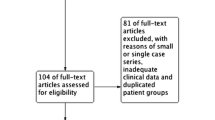Abstract
Purpose
The enteric nervous system (ENS), comprising neurons and glial cells, organized as interconnected ganglia within the gut wall, controls peristalsis and the production of secretions. The RET receptor tyrosine kinase is expressed throughout enteric neurogenesis and is required for normal ENS development. Humans with mutations in the RET locus have Hirschsprung’s disease (HSCR), and mice lacking RET exhibit total intestinal aganglionosis. Although a number of mutations with the potential for causing HSCR have been reported, their precise correlation with phenotype and symptom severity in HSCR is not clearly understood. Our study investigates the correlation between mutations in the RET locus and symptom severity in HSCR.
Methods
We performed a comprehensive nucleotide analysis of the RET coding region in 18 HSCR patients and 87 controls, performed cellular biological analysis by Western blotting using the expression vector, and analyzed cell proliferation with anti-Ki67 antibody under immunofluorescence confocal microscopy (ICM).
Results
We identified three novel mutations, D489N, L769L, and V778D in the RET coding region in our HSCR patients. In the allelic distribution of D489N and L769L, the difference between HSCR patients and controls reached statistical significance (p = 0.0373 and p = 0.0004, respectively), whereas no statistical difference was observed in the allelic distribution of V778D (p = 0.1073). One HSCR patient who died from total colonic aganglionosis had a combination of homozygous mutation of D489N, L769L, and heterozygous mutation of V778D. Western blotting of full mutant RET from this patient showed significantly increased 150kD-band, which corresponds to the immature form compared with wild-type and single mutant RET. ICM showed that overexpression of full mutant RET significantly reduced cellular proliferation in comparison with wild-type and single mutant RET.
Conclusion
A combination of mutations in the RET locus may correlate with symptom severity in HSCR as a consequence of reduced cellular proliferation secondary to altered maturation of RET.


Similar content being viewed by others
References
Amiel J, Sproat-Emison E, Garcia-Barcelo M et al (2008) Hirschsprung disease, associated syndromes and genetics: a review. J Med Genet 45:1–14
Emison ES, McCallion AS, Kashuk CS et al (2005) A common sex-dependent mutation in a RET enhancer underlies Hirschsprung disease risk. Nature 434(7035):857–863
Passarge E (2002) Dissecting Hirschsprung disease. Nat Genet 31(1):11–12 Epub 2002 Apr 15
Taraviras S, Marcos-Gutierrez CV, Durbec P et al (1999) Signalling by the RET receptor tyrosine kinase and its role in the development of the mammalian enteric nervous system. Development 126(12):2785–2797
Uesaka T, Jain S, Yonemura S et al (2007) Conditional ablation of GFRalpha1 in postmigratory enteric neurons triggers unconventional neuronal death in the colon and causes a Hirschsprung’s disease phenotype. Development 134(11):2171–2181
Sánchez-Mejías A, Fernández RM, López-Alonso M et al (2010) New roles of EDNRB and EDN3 in the pathogenesis of Hirschsprung disease. Genet Med 12(1):39–43
Pan ZW, Lou J, Luo C et al (2011) Association analysis of the SOX10 polymorphism with Hirschsprung disease in the Han Chinese population. J Pediatr Surg 46(10):1930–1934
Avantaggiato V, Dathan NA, Grieco M et al (1994) Developmental expression of the RET protooncogene. Cell Growth Differ 5(3):305–311
Takahashi M, Asai N, Iwashita T et al (1993) Characterization of the ret proto-oncogene products expressed in mouse L cells. Oncogene 8(11):2925–2929
Airaksinen MS, Saarma M (2002) The GDNF family: signalling, biological functions and therapeutic value. Nat Rev Neurosci 3(5):383–394
Gustin JA, Yang M, Johnson EM Jr et al (2007) Deciphering adaptor specificity in GFL-dependent RET-mediated proliferation and neurite outgrowth. J Neurochem 102(4):1184–1194
Bordeaux MC, Forcet C, Granger L et al (2000) The RET proto-oncogene induces apoptosis: a novel mechanism for Hirschsprung disease. EMBO J 19(15):4056–4063
Schuchardt A, D’Agati V, Larsson-Blomberg L et al (1994) Defects in the kidney and enteric nervous system of mice lacking the tyrosine kinase receptor Ret. Nature 367(6461):380–383
Uesaka T, Nagashimada M, Yonemura S et al (2008) Diminished Ret expression compromises neuronal survival in the colon and causes intestinal aganglionosis in mice. J Clin Invest 118(5):1890–1898
Kjaer S, Ibáñez CF (2003) Intrinsic susceptibility to misfolding of a hot-spot for Hirschsprung disease mutations in the ectodomain of RET. Hum Mol Genet 12(17):2133–2144
Auricchio A, Griseri P, Carpentieri ML et al (1999) Double heterozygosity for a RET substitution interfering with splicing and an EDNRB missense mutation in Hirschsprung disease. Am J Hum Genet 64(4):1216–1221
Wu TT, Tsai TW, Chu CT et al (2005) Low RET mutation frequency and polymorphism analysis of the RET and EDNRB genes in patients with Hirschsprung disease in Taiwan. J Hum Genet 50(4):168–174
Garcia-Barceló MM, Sham MH, Lui VC et al (2003) Chinese patients with sporadic Hirschsprung’s disease are predominantly represented by a single RET haplotype. J Med Genet 40(11):e122
Sangkhathat S, Kusafuka T, Chengkriwate P et al (2006) Mutations and polymorphisms of Hirschsprung disease candidate genes in Thai patients. J Hum Genet 51(12):1126–1132
Iwashita T, Kurokawa K, Qiao S et al (2001) Functional analysis of RET with Hirschsprung mutations affecting its kinase domain. Gastroenterology 121(1):24–33
Diaz-Rodriguez E, García-Lavandeira M, Perez-Romero S et al (2011) Direct promoter induction of p19Arf by Pit-1 explains the dependence receptor RET/Pit-1/p53-induced apoptosis in the pituitary somatotroph cells. Oncogene 31(23):2824–2835
Author information
Authors and Affiliations
Corresponding author
Rights and permissions
About this article
Cite this article
Ishii, K., Doi, T., Inoue, K. et al. Correlation between multiple RET mutations and severity of Hirschsprung’s disease. Pediatr Surg Int 29, 157–163 (2013). https://doi.org/10.1007/s00383-012-3196-1
Published:
Issue Date:
DOI: https://doi.org/10.1007/s00383-012-3196-1




